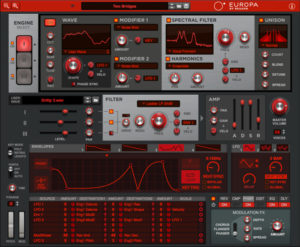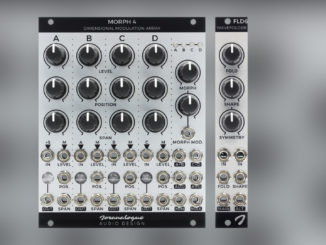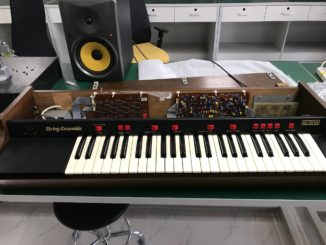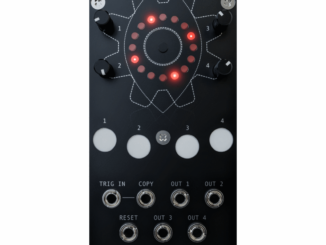Propellerhead Software’s first Synthesizer plugin is called Europa, its base is a spectral wavetable engine, and it showed in the test that it offers a lot of sound design options!
Propellerhead has been known to fully support the DAW Reason and their rack extensions. At the end of May, the company caused a great deal of wonder in the music production world when they released their first VST/AU Synthesizer Europa. It’s a port of the synth which is already built-in since Reason 10. The review refers to the plugin version but also to those already installed in the new Reason 10.
Europa is described on the official developer website as a Shape-Shifting Synthesizer which can be also described as wavetable synth with extended spectral features. The engine is based on a classic subtractive architecture (Osc, filter, envelope, LFO, amp…) but has been extended with some exciting new features.
3 Oscillators (Engines) & Their Large Selection Of Shapers Provide Almost Infinite Sounds
The signal chain of almost every Synthesizer starts with the oscillators. In Europa, there are 3 oscillators, so-called engines. Among the big strengths of Europa are the three oscillators, so-called engines. Every engine is based on the same architecture: Wave – Modifier I – Modifier II – Spectral – Harmonics – Unison. In this area, one thing is the foreground: shaping the perfect sound. There are more than 30 wavetables available to choose from ranging from traditional analog to complex and dynamic waveforms.
If that’s not enough, you can always import your own samples to generate own waveforms and design even more sounds. In addition to the classic oscillator features, here is also a one-knob shaper function available with which one can further deform the waveforms or wavetables. This process can also be automated by a wide range of modulators (envelope, LFO…)
In a second step, you can further deform the waveforms using two modifiers. Here are 32 different shapers variants available with which you can intensively change the character of the core sound. Here you will find, among other things: hard sync, invert, downsample, phase distort, hard clip, glitch, harmonics, FM, formant & more. With the wide assortment of shapers, you can just sit there for hours and play around with them. The parameters of both blocks are also easy to modulate.
Spectral Filter For Your Harmonics
After the modifier section, the signal moves on to a spectral filter. In this single harmonics of the wave are addressed and can be edited with this. Here are 15 different filters available to the user. If these are not enough, you can also load own samples here and get your own spectral filter type. Additional, it’s possible to manipulate further the harmonics of the filtering processing using 8 different shapes. A sound design problem, in my opinion, is that you are forced to use the same sample for the waveform and the filter. Unfortunately, there is no way to take one sample for the waveform and another for the filter. Also, all three engines can only use the same sample. Here I would be pleased if the developer will expand this. Additional, it’s possible to manipulate further the harmonics of the filtering processing using 8 different shapers.
Nonetheless, you can use the spectral filter to process its waveform very excitingly. So they get richer in harmonics, get a different character or they sound duller. Everything depends on the sound designer here. Again, the parameters can be easily modulated with an envelope, LFO etc. In the last step, you can work with a powerful Unison feature that has 5 different types. With 4 parameters, it can be further processed. The more interesting thing about this Unison feature is that it occurs in every engine and thus acts independently.

Mixer – Filter – Amp (The Simplest Section Of Europa)
When you are done with the oscillators, all three signals are merged in a mixer. Here it’s possible to pan each signal correctly. Then it goes further into a classic filter where the user can decide which signal should go inside. Europa leaves the freedom to use it or not. If you don’t use the filter, the signal goes immediately into the app. If you use it here you have 9 different filter types to choose from. They range from a classic ladder, state variable filters and more. It all sounds nice and solid. With the additional drive effect, you can bring some dirt into the filter which is especially good for more aggressive sounds. Furthermore, the filter parameters can be modulated with the usual modulators (LFO, envelope, velocity…). After this step, the signal enters in an amp section where a classic ADSR envelope is active. This can be panned and an additional velocity option for the gain can be activated. On the far right, there is a master volume knob and the amount of polyphony (up to 16!)
The Fun Is In The Modulators
Where many Synthesizer plugins only use classic envelopes, Europa is one step ahead. As a whole, the user has four complete envelopes available. The most exciting thing about it is that you can use it as a classic ADSR or modify it completely. Thus, with the help of a few clicks, the envelope can be quickly extended with further points that allow you to design complex modulators. The envelope fantasy is almost limitless in Europa.
Another interesting feature that gave me a lot of pleasure in the test is the loop function. Envelopes can be easily looped here and used as quasi LFO. This feature opens the door to many new complex sounds. Since you can route these envelopes to almost any parameter, you can achieve the craziest results. To make it easy to get started, Europa comes with 20 pre-designed shapes from simple to crazy. If you set it to a slower tempo, then a melodic texture is possible or even to point out specific sounds. If you set it higher, it can become very wild and crazy. A very nice and useful feature in my opinion with which you can have a lot of fun. On top, you have three LFO slots with 10 different shapes for additional modulation options. With a handy delay function, you can also add a delay to the modulation very easy.
Modulation Matrix – Simple & Long Proven!
A modulation matrix is near in every software Synthesizer today. Europa, too, relies on a classic matrix in which one can enter sources and destinations. Here you can easily enter up to 8 modulations. 8 are already sufficient in my opinion, over more entries some sound designers are maybe happier. If you plan to use a lot of modulators and want to use one a second time, you can select a second destination directly in the MM. This a good solution and allows more flexibility.
Also interesting to know is that some other modulators are hidden in the MM. For example, there is a randomizer, performance-oriented modulators (aftertouch, breath, expression…) noise etc. Thus, Europa offers the user a very wide range of modulators to choose from. I’m satisfied to see that the developer has decided to use a classic MM because this is an easy and fast process.
Effects To Round Off The Sound!
The effects should not be missing in the Europa Synthesizer. If you are looking forward to crazy processors, unfortunately, there is some disappointment. The developers rely on 8 easy-to-use good sounding effects where 5 are only used at the same time (distortion, EQ, delay, compressor, reverb). In the Chorus, Flanger, Phaser section, you must choose one effect. The signal chain of the effects can also be adjusted to suit your needs. Additionally, it’s possible to modulate individual parameters of the effects directly inside the modulation matrix. With a push, you can also bypass all the effects of Europa.








Be the first to comment